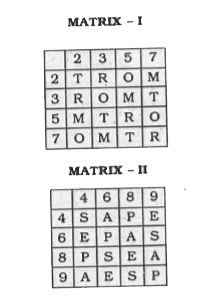Shailja can express a number in different way, e.g. 4=2+2 or 4=1+3 etc. In which developmental phase of numbers is she?
Quantifying phase
Partitioning phase
Factoring phase
Operating phase
The correct Answer is:B
To determine the developmental phase of numbers that Shailja is in, we need to analyze her ability to express the number 4 in different ways, such as 4=2+2 and 4=1+3.
1. Understanding the Question: We need to identify the developmental phase of numbers that Shailja is demonstrating when she expresses a number in different ways.
2. Identifying the Options: The options provided are:
- Quantifying phase
- Partitioning phase
- Factoring phase
- Operating phase
3. Analyzing Each Phase:
- Quantifying Phase: This phase involves understanding and computing values like percentages and fractions. Since Shailja is simply expressing the number 4 in different ways, this phase does not apply.
- Factoring Phase: In this phase, a child understands factors of numbers and can express a number as a product of its factors. Shailja is not expressing 4 in terms of its factors (like 2x2 or 1x4), so this phase does not apply either.
- Operating Phase: This phase involves performing operations such as addition, subtraction, multiplication, and division. While Shailja is adding numbers to express 4, she is not performing operations in the sense of manipulating numbers through calculations, so this phase does not apply.
- Partitioning Phase: This phase is characterized by the ability to divide a number into different parts or sums. Since Shailja can express 4 as 2+2 and 1+3, she is effectively partitioning the number into different components.
4. Conclusion: Based on the analysis, Shailja is in the Partitioning Phase of number development because she is dividing the number 4 into different sums.
Final Answer:
Shailja is in the Partitioning Phase of number development.
- Quantifying phase
- Partitioning phase
- Factoring phase
- Operating phase
- Quantifying Phase: This phase involves understanding and computing values like percentages and fractions. Since Shailja is simply expressing the number 4 in different ways, this phase does not apply.
- Factoring Phase: In this phase, a child understands factors of numbers and can express a number as a product of its factors. Shailja is not expressing 4 in terms of its factors (like 2x2 or 1x4), so this phase does not apply either.
- Operating Phase: This phase involves performing operations such as addition, subtraction, multiplication, and division. While Shailja is adding numbers to express 4, she is not performing operations in the sense of manipulating numbers through calculations, so this phase does not apply.
- Partitioning Phase: This phase is characterized by the ability to divide a number into different parts or sums. Since Shailja can express 4 as 2+2 and 1+3, she is effectively partitioning the number into different components.
Shailja is in the Partitioning Phase of number development.
Similar Questions
Knowledge Check
In the following two questions, given below are the two matrices each containing two classes of letters from the alphabets. The columns and rows of Matrix I are prime numbered and that of Matrix II are composite numbered. Letter from these matrices can be represented first by its row number and next by its column number. e.g. P can be written as 48, 66, 84 etc. In the following questions identify one set of number pairs out of (1), (2), (3) and (4) which represent the given word. APES
 A46, 48, 49, 44B96, 94, 98, 99C69, 64, 66, 68D84, 86, 89, 88
A46, 48, 49, 44B96, 94, 98, 99C69, 64, 66, 68D84, 86, 89, 88In the following two questions, given below are the two matrices each containing two classes of letters from the alphabets. The columns and rows of Matrix I are prime numbered and that of Matrix II are composite numbered. Letter from these matrices can be represented first by its row number and next by its column number. e.g. P can be written as 48, 66, 84 etc. In the following questions identify one set of number pairs out of (1), (2), (3) and (4) which represent the given word. ROME
 A57, 55, 52, 88B23, 25, 27, 49C64, 35, 33, 32D96, 73, 77, 72
A57, 55, 52, 88B23, 25, 27, 49C64, 35, 33, 32D96, 73, 77, 72In the given figure, what is the maximum number of different ways in which 8 identical balls can be placed in the small triangles 1, 2, 3 and 4 such that each triangle contains at least one ball?
 A32B35C44D56
A32B35C44D56
Let f(n) denotes the number of different ways, the positive integer n ca be expressed as the sum of the 1's and 2's. for example, f(4)=5.
i.e., 4=1+1+1+1
=1+1+2=1+2+1=2+1+1=2+2
Q. In a stage show, f(4) superstars and f(3) junior artists participate. each one is going to present one item, then the number of ways the sequence of items can be planned, if no two junior artists present their items consecutively, is
View SolutionIn how many different ways can 6 identical balls be distributed to 4 different boxes , when each box can have any number of balls ?
View SolutionIn how many different ways can 6 different balls be distributed to 4 different boxes, when each box can hold av number of ball?
View SolutionIn how many ways can 729 be expressed as a difference of the square of whole numbers?
View SolutionIn how many ways can 729 be expressed as a difference of the square of whole numbers?
View Solution
